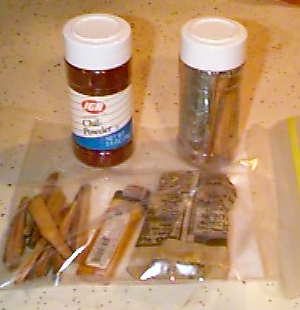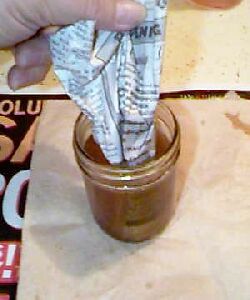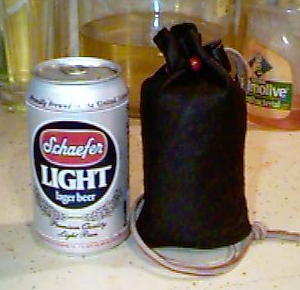|
On cold, drizzly winter days, my father would often tell the tale of the time he and my brother Robert and I got lost while squirrel hunting. My brother and I can't remember the incident, so we were surely no more than four or five years old at the time. It happened on an afternoon hunt in the once vast hardwood bottom where Bayou Funny Louis meets Little River here in LaSalle Parish Louisiana. It started raining, so Dad headed back to his car, his hunting sack loaded down with fox squirrels. In addition to the squirrels and a double-barrel 12-gauge shotgun, he also toted the smaller boy on his hip while the slightly larger boy, me, tagged behind, crying, "Daddy, I'm tired." At some point in the journey back to the car, he noticed he had passed a lightning-struck tree for the second time. With darkness approaching, he stopped to collect his bearings, finally starting out again but in a new direction. When darkness came, he continued by light of a flashlight. But when the flashlight beam grew dim, he stopped, knowing he was in trouble. Imagine his predicament: two crying children and lost in deep woods on a rainy winter night. Many men would have panicked. But my father used the remaining light from the flashlight to find a pitch-pine stump, what country folks call "rich lightered pine." At close range, he blasted the stump with the shotgun. With his pocket knife, he then cut open a 12-gauge shell and dumped the powder in a dry spot beside the stump. He then gathered tiny blasted-off pieces of the stump and placed them on the little pile of powder, topping them with larger pieces of the stump. He ignited the powder with his cigarette lighter, and in just a few minutes he had a roaring fire. He fired his shotgun into the air until he ran out of shells. Sometime during that cold, wet, miserable night and far off somewhere in the night he heard his uncle Dan Hawthorne on a mule and yelling, "John Lee! Johnnnnnn Leeeeeeeeeeeee!!!" Since Uncle Dan was half-deaf, my dad's answering yells did no good. So there we spent the night. Dad said my brother and I curled up beside the fire and slept just fine, all warm and cozy. At the crack of dawn, he heard the crow of a far-away rooster. He roused my brother and I, and off we went in the direction of the rooster. About fifty yards from our fire, Dad swore, there was a gravel road. So we all lived to hunt again. My father did not panic, and he had the foresight to carry a cigarette lighter and a flashlight. In the years since then, I can remember twice when I needed an emergency fire or warmth. Once while duck hunting, I fell in the lake. The car was an unbelievably cold boat ride away, but the car's motor started and the heater finally blew warm air over me. One frosty day while squirrel hunting with a friend just a couple of miles from home, I stepped on an ice patch on a log over Cockerham Creek and landed flat on my back in the nearly frozen water. Somehow my friend built a fire. With those chilly memories in mind, I decided to build myself a possibles bag fire starting kit. I can't see myself getting lost, especially near home where I hunt, but I can see the possibility of my car getting stuck or not starting. So the little kit will stay in my car unless I'm hunting a mile or so from my car, in which case the little kit will reside in or attached to my possibles bag or fanny pack. My kit had two major requirements:
It contains wax coated newspaper, wax coated toothpick- and cigarette-sized pitch pine segments, and a throw-away cigarette lighter wrapped in plastic sandwich wrap. The lighter is the green/gray object inside the bottle. By looking closely through the clear plastic bottle at the wrapped lighter I can see the liquid butane inside the lighter and know whether it is full or not. The wax coated newspaper is pushed inside the little bottle on top of the pine segments and the wrapped lighter, holding them all inside the bottle if it is upended. With the lid off the bottle and its contents held inside, I upended the bottle and dipped its rim in liquid wax; thus sealing it when I replaced the lid. No way is water getting inside that little bottle. At the bottom of the above photo and in a zip freezer bag, you see the maybe waterproof kit. From left to right, it contains wax coated pitch pine segments, a throw-away cigarette lighter, and wax coated newspaper. Use a zip freezer bag and not a zip sandwich bag. A freezer bag is twice as thick as a sandwich bag—.003" vs .0015". Therefore it is twice as sturdy. If the ground is wet, start your fire on top of the freezer bag. It will keep your tinder dry, and it will also burn nicely. The plastic chili powder bottle and its cap will also burn nicely. If you have trouble igniting larger chunks of wood because of wetness, etc., add the bottle to your little fire.
If I happen to take an accidental and icy swim in a lake or a creek and need an emergency fire, I know two facts:
You can use paraffin or beeswax. I used beeswax and melted it in my microwave in a home-canning jelly jar. Canning jars are tough and built for high temperatures. If you don't have a canning jar, melt your wax in a double-boiler in boiling water. (Do not use a jar which contained store-bought jelly. They are not as tough as home-canning jars.)
The bag started uncut as a 4 3/4" x 14" strip of suede leather. I left the tie lace long so I could tie it to whatever. The kit as you see it weighs exactly 6 ozs. The beer can, full and cold, is for size reference and for drinking after photo sessions. If you'll notice at the top of the bag, I ran the lace through red beads to give the bag a buckskinner look. It looks cool, in my opinion. The kit is a little more bulky than I had planned, but at only 6 ozs it's light. In fact, it weighs exactly the same as three 12-gauge shotgun shells. I can put it inside or tie it to my possibles bag or fanny pack. It will even go around my neck. Whatever the case, it will be there if I need it. The day (or night) will come when I'll need that fire starting kit. When I do, one or both of my lighters will light and my wax coated newspaper and pine will burst into flames. When they do, my cold and wet butt will soon feel warm and cozy, just like on that night so long ago near Bayou Funny Louis.
|
 The kit is actually two kits in one—a positively waterproof kit and a maybe waterproof kit. Each kit contains a cigarette lighter, tinder, and tiny segments of pitch pine. For a waterproof container I used an empty plastic chili powder bottle. At the top left and for reference, see a new 2.5 oz chili powder bottle. At the top right, see a used 2.5 oz chili powder bottle converted into a positively waterproof fire starting kit.
The kit is actually two kits in one—a positively waterproof kit and a maybe waterproof kit. Each kit contains a cigarette lighter, tinder, and tiny segments of pitch pine. For a waterproof container I used an empty plastic chili powder bottle. At the top left and for reference, see a new 2.5 oz chili powder bottle. At the top right, see a used 2.5 oz chili powder bottle converted into a positively waterproof fire starting kit. In this photo, you see me dipping a piece of newspaper in liquid wax. The piece of newspaper is about 6" square. I dipped one end of the newspaper and the pine segments into the wax, then let them dry for a moment, then dipped the other ends. The wax not only serves to waterproof the paper and the pine, it will burn and provide extra fire fodder.
In this photo, you see me dipping a piece of newspaper in liquid wax. The piece of newspaper is about 6" square. I dipped one end of the newspaper and the pine segments into the wax, then let them dry for a moment, then dipped the other ends. The wax not only serves to waterproof the paper and the pine, it will burn and provide extra fire fodder. Here we see the positively waterproof kit and the maybe waterproof kit both tucked inside a black leather bag made just for them. I did not include a flashlight in my fire starting kit because on afternoon hunts I carry one in a sheath attached to my belt. There is plenty of room in the kit for a AAA mini light.
Here we see the positively waterproof kit and the maybe waterproof kit both tucked inside a black leather bag made just for them. I did not include a flashlight in my fire starting kit because on afternoon hunts I carry one in a sheath attached to my belt. There is plenty of room in the kit for a AAA mini light.